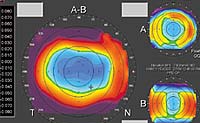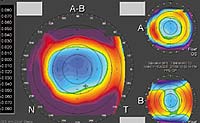Intacs after LASIK restores prolate corneal shape
LASIK creates an oblate cornea, so Intacs after LASIK may improve visual outcomes.
BOSTON - Intacs micro-thin prescription inserts (KeraVison, Fremont, Calif.) following uncorrected myopic laser in situ keratomileusis (LASIK) is a safe and effective method to treat residual myopia, according to Andrew L. Moyes, MD.
Dr. Moyes prospectively assessed the refractive and topographical results of patients who underwent Intacs implantation after previously undercorrected myopic LASIK. In some cases, remaining corneal thickness prohibited further central ablation, even though patients had between 1 D and 3 D of residual myopia.
Dr. Moyes presented his results at the American Society of Cataract and Refractive Surgery meeting.
"Intacs surgery is a lot of fun to do. This is one of the most fun and coolest toys that we get to use," Dr. Moyes said.
Reverse LASIK's effect
 ---Difference anterior elevation (OD) one hour after implanting Intacs.
---Difference anterior elevation (OD) one hour after implanting Intacs.
Dr. Moyes also implanted Intacs to partially reverse LASIK's induction of an oblate cornea. Also, he added, presbyopes might benefit from treating the dominant eye completely with LASIK and target a –2.5-D refraction in the fellow eye to titrate as needed.
"An interesting area that we've not looked at is whether or not Intacs has a role in actually stunting or stabilizing the cornea in a patient who is becoming ectatic," Dr. Moyes said.
Intacs preserves a positive asphericity or the prolate surface, whereas LASIK gives an oblate surface, he said.
Dr. Moyes explained the concept of corneal shape as a camper standing in a tent.
"If your head is underneath a tent, and that is the shape of your cornea, in LASIK, essentially we are chopping your head off, and then the tent falls down on your shoulder to flatten the cornea," he said. "In Intacs surgery, we're stretching our arms up, and as the arms come up, there is a counter-balancing force that pushes our head down so our head is still up but it's pushed slightly down."
Intacs also increases the size of the optical zone, which in turn improves visual acuity, Dr. Moyes said. Topography showed that patients with small optical zones after LASIK had zones up to 7 mm after Intacs placement. This increases the prolate nature of the cornea.
Study in progress
 ---Difference anterior elevation (OS) one hour after implanting Intacs.
---Difference anterior elevation (OS) one hour after implanting Intacs.
His study will examine as many as 25 eyes using the standard technique. He will look at safety parameters, best spectacle corrected visual acuity and any surgical complications, as well as uncorrected visual acuity, predictability and stability.
"To date, this is a very preliminary and initial report," Dr. Moyes said. "All of the surgical procedures have been uneventful. [There were] no complications with the LASIK flap."
Healing has been typical for Intacs, and surgeons have noticed a significant improvement in night vision in a number of post-LASIK Intacs patients. Treating the residual amount of myopia is probably the number one reason, although uncorrected myopia has significant glare at night as well.
Early results show a predictable refractive result, enlargement of the optical zone and an increase in the amount of prolate shape of the central cornea. No complications happened during the procedure.
"This is a very interesting concept," Dr. Moyes said. "It's a very preliminary work in this field of using Intacs as enhancement to LASIK, and the long-term results certainly need to be evaluated. We've shown no intraoperative or early postoperative complications to this point. As far as the feasibility of proceeding, it looks very good. This may help patients achieve more myopic correction than can be obtained with LASIK alone."
For Your Information:
- Andrew L. Moyes, MD, can be reached at 211 NE 54th St., Ste. 202, Kansas City, MO 64118-4362; (816) 455-2020; fax: (816) 459-5690.
